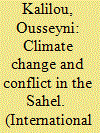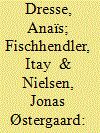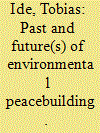|
|
|
Sort Order |
|
|
|
Items / Page
|
|
|
|
|
|
|
| Srl | Item |
| 1 |
ID:
191575


|
|
|
|
|
| Summary/Abstract |
Environmental stress contributes to food insecurity, poverty, forced migration and violent conflict in the Sahel, with climate change aggravating the situation. The production of gum arabic from the acacia tree increasingly aligns with the community stakeholders’ efforts to promote climate change mitigation, adaptation and resilience. Based on expert interviews and field observations in Niger, and a reading of relevant documents, I found that gum arabic production is valuable for conflict mitigation because it helps tackle the root causes of violent conflicts. The acacia gum tree is a natural soil fixer and multinational companies have coveted the resin from the tree, which is a rising commodity and a promising source of revenue for the local inhabitants. As different communities work together and cooperate with outside actors (government agencies, international partners, NGOs and businesses), the opportunities to build social cohesion around the tree increase. By facilitating ecological improvement, social inclusion and poverty alleviation, the promotion of gum arabic production, despite other issues such as bad natural resource governance, is a critical environmental peacebuilding strategy. Hence, suitable funding of massive afforestation with the acacia tree fits with community-based natural climate solutions to global humanitarian issues by protecting and restoring the local environment.
|
|
|
|
|
|
|
|
|
|
|
|
|
|
|
|
| 2 |
ID:
163502


|
|
|
|
|
| Summary/Abstract |
Environmental peacebuilding represents a paradigm shift from a nexus of environmental scarcity to one of environmental peace. It rests on the assumption that the biophysical environment’s inherent characteristics can act as incentives for cooperation and peace, rather than violence and competition. Based on this, environmental peacebuilding presents cooperation as a win-win solution and escape from the zero-sum logic of conflict. However, there is a lack of coherent environmental peacebuilding framework and evidence corroborating the existence of this environment-peace nexus. Building on a multidisciplinary literature review, this article examines the evolution of environmental peacebuilding into an emerging framework. It unpacks the concept and explains its main building blocks (conditions, mechanisms and outcomes) to develop our understanding of when, how and why environmental cooperation can serve as a peacebuilding tool. It assembles these building blocks into three generic trajectories (technical, restorative and sustainable environmental peacebuilding), each characterised according to their own causality, drivers and prerequisites, and illustrated with concrete examples. Finally, this article draws attention to the remaining theoretical gaps in the environmental peacebuilding literature, and lays the foundations for an environmental peacebuilding research agenda that clarifies if and how environmental cooperation can spill over across borders, sectors and scales towards sustainable peace.
|
|
|
|
|
|
|
|
|
|
|
|
|
|
|
|
| 3 |
ID:
191570


|
|
|
|
|
| Summary/Abstract |
Environmental peacebuilding is the integration of natural resource management into conflict prevention, resolution and recovery so as to support peace and environmental sustainability. Most studies have been of cases where there is significant involvement of external (usually international) actors. They thus provide implicit support for liberal peacebuilding practice, which is itself the subject of much critique. Conversely, documented examples of environmental peacebuilding from below are rare. We analyse an endogenously emerging environmental peacebuilding institution, the customary tara bandu process in Timor-Leste. We explain the way tara bandu is used bottom-up to promote the sustainable use of natural resources and more peaceful relations. Tara bandu proves to be a successful, locally diverse environmental peacebuilding institution. We further show how recent attempts by international peacebuilders and state institutions to employ tara bandu have somewhat ignored the way it is deeply interwoven with local social and spiritual relations, and in so doing have jeopardized its legitimacy and efficacy. This suggests that attempts from outside actors to facilitate environmental peacebuilding may be constrained by a mismatch between theorized norms of social and environmental relations (such as ‘shared interests’) and local cultural particularities.
|
|
|
|
|
|
|
|
|
|
|
|
|
|
|
|
| 4 |
ID:
191565


|
|
|
|
|
| Summary/Abstract |
Environmental peacebuilding is a rapidly growing field of research and practice at the intersection of environment, conflict, peace and security. Focusing on these linkages is crucial in a time when the environment is a core issue of international politics and the number of armed conflicts remains high. This article introduces a special issue with a particular emphasis on environmental opportunities for building and sustaining peace. We first detail the definitions, theoretical assumptions and intellectual background of environmental peacebuilding. The article then provides context for the special issue by briefly reviewing core findings and debates of the first two generations of environmental peacebuilding research. Finally, we identify knowledge gaps that should be addressed in the next generation of research, and to which the articles in this special issue contribute: bottom-up approaches, gender, conflict-sensitive programming, use of big data and frontier technology, and monitoring and evaluation.
|
|
|
|
|
|
|
|
|
|
|
|
|
|
|
|
| 5 |
ID:
151511


|
|
|
|
|
| Summary/Abstract |
The concept of environmental peacebuilding is becoming increasingly prominent among peacebuilding scholars and practitioners. This study provides a brief overview about the various discussions contributing to our understanding of environmental peacebuilding and concludes that questions of space have hardly been explicitly considered in these debates. Drawing on discourse-analytic spatial theory, I discuss how the social construction of scale, place and boundaries are relevant for environmental peacebuilding processes and outcomes. This theoretical approach is then applied to the Good Water Neighbours project, which aims at improving the regional water situation and at building peace between Israelis, Palestinians and Jordanians. The results suggest that discursive constructions of space are important in facilitating, impeding or shaping environmental peacebuilding practices. Analyses of environmental peacebuilding, but also of peacebuilding more general, are therefore encouraged to draw more strongly on the findings of spatial theory.
|
|
|
|
|
|
|
|
|
|
|
|
|
|
|
|
|
|
|
|
|